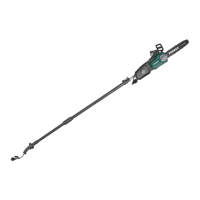p) Recommendation to have sharpening and maintenance of the saw
chain performed by authorised service centres.
2) Causes and operator prevention of kickback:
Kickback may occur when the nose or tip of the guide bar touches an object,
or when the wood closes in and pinches the saw chain in the cut.
Tip contact in some cases may cause a sudden reverse reaction, kicking the
guide bar up and back towards the operator.
Pinching the saw chain along the top of the guide bar may push the guide
bar rapidly back towards the operator.
Either of these reactions may cause you to lose control of the saw which
could result in serious personal injury. Do not rely exclusively upon the safety
devices built into your saw. As a chain saw user, you should take several steps
to keep your cutting jobs free from accident or injury.
Kickback is the result of chain saw misuse and/or incorrect operating
procedures or conditions and can be avoided by taking proper precautions
as given below:
a) Maintain a rm grip, with thumbs and ngers encircling the chain saw
handles, with both hands on the saw and position your body and arm
to allow you to resist kickback forces.
Kickback forces can be controlled
by the operator, if proper precautions are taken. Do not let go of the chain
saw.
b) Do not overreach and do not cut above shoulder height.
This helps
prevent unintended tip contact and enables better control of the chain saw
in unexpected situations.
c) Only use replacement bars and chains specied by the manufacturer.
Incorrect replacement guide bars and saw chains may cause chain breakage
and/or kickback.
d) Follow the manufacturer’s sharpening and maintenance instructions for
the saw chain.
Decreasing the depth gauge height can lead to increased
kickback.
For chain saw with the extended pole safety warnings
1. Do not use the machine when the operator is tired, ill or under the inuence
of alcohol or other drugs.
2. To reduce the risk, please keep bystanders at a safe distance from the
9

